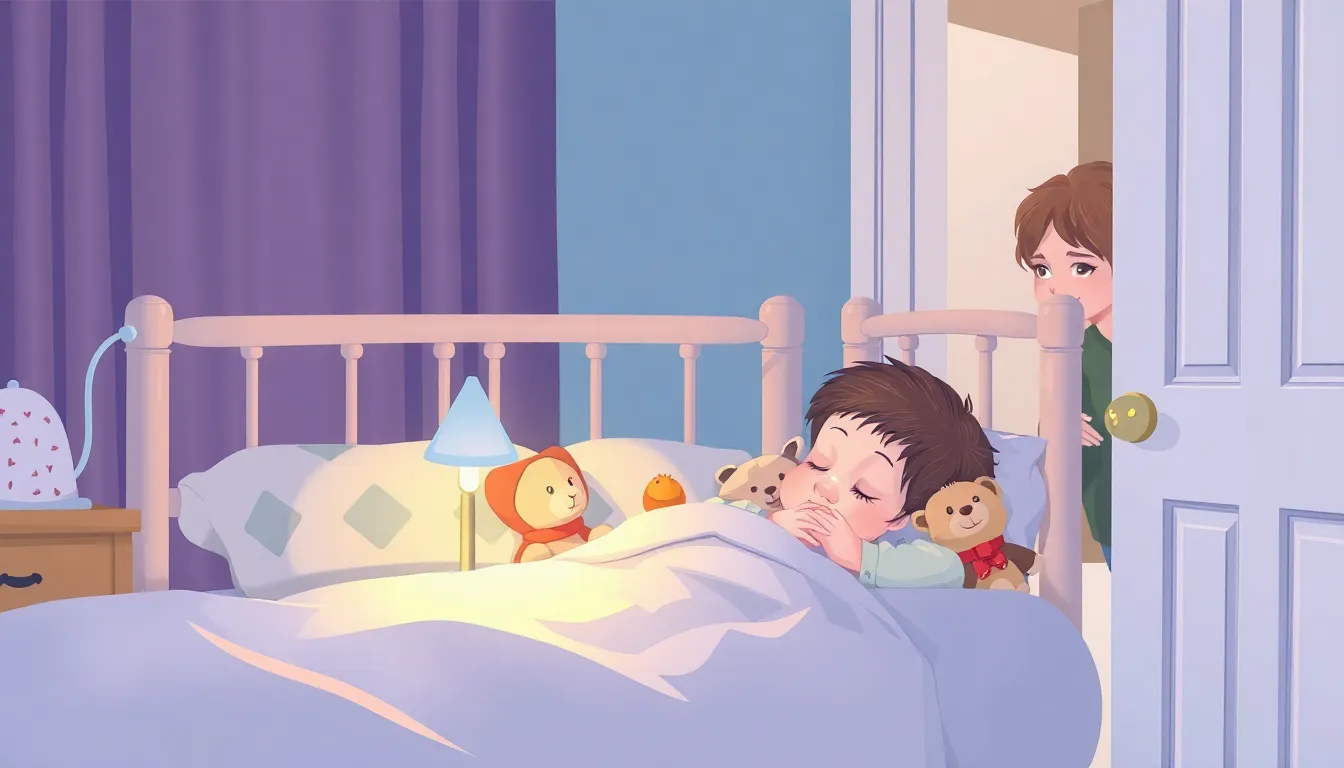Night terrors in toddlers can feel like a scene straight out of a horror movie, but don’t worry; it’s not as scary as it sounds. Picture this: a peaceful night suddenly interrupted by your little one screaming, flailing, and looking like they’ve just spotted a ghost. What’s behind this frightful phenomenon? Understanding the causes can help parents navigate these spooky episodes with a little more ease.
These nighttime escapades often leave parents scratching their heads and wondering if they should call in the Ghostbusters. But fear not! Night terrors are surprisingly common and usually harmless. By exploring the factors that contribute to these episodes, parents can gain insight into their child’s sleep patterns and find ways to help them feel safe and secure during the night. Let’s dig into the causes of these little nightmares and discover how to turn those terror-filled nights into peaceful slumbers.
Table of Contents
ToggleUnderstanding Night Terrors in Toddlers
Night terrors in toddlers manifest as intense episodes of fear during sleep. These occurrences typically happen within one to two hours after falling asleep, often during deep non-REM sleep. While the child appears awake and terrified, they remain in a state of confusion and disorientation.
Genetic factors play a significant role in night terrors. Children with a family history of sleep disorders often experience more frequent episodes. Stressful situations, such as starting preschool or changes in family dynamics, can trigger these disturbances as well.
Sleep deprivation significantly increases the likelihood of night terrors. Kids who do not get adequate sleep, defined as 10 to 14 hours per night for toddlers, may display a higher risk of experiencing these incidents. Establishing a consistent bedtime routine fosters better sleep patterns and can reduce occurrences.
Psychological factors contribute to night terrors. Every child reacts differently to stress or anxiety, and those with heightened sensitivity might be more prone to these episodes. Additionally, overexcitement or overstimulation before bedtime can lead to a restless night.
Medical conditions such as sleep apnea or fever can exacerbate night terrors. If a toddler suffers from breathing difficulties during sleep or has a chronic illness, night terrors may become more common. Consulting a healthcare professional provides essential insights when these episodes occur frequently.
Understanding these elements helps parents manage night terrors effectively. Parents can create a calming sleep environment and maintain regular sleep schedules to alleviate anxiety connected to nighttime fears. A supportive approach allows toddlers to feel secure, reducing the intensity and frequency of night terrors.
Common Triggers for Night Terrors

Night terrors in toddlers often stem from various common triggers. Understanding these factors helps in managing episodes and ensuring a more restful night.
Sleep Deprivation
Sleep deprivation plays a significant role in triggering night terrors. Toddlers require 11 to 14 hours of sleep each night for optimal growth and development. Reduced sleep increases stress on their developing brains, leading to disturbances during deep sleep cycles. Research indicates that children who experience irregular sleep patterns or insufficient sleep are more prone to night terrors. Parents can mitigate this issue by establishing consistent bedtime routines and promoting an environment conducive to sleep. A structured schedule supports better sleep hygiene, ultimately reducing the occurrence of night terrors.
Stress and Anxiety
Stress and anxiety also contribute to night terrors in toddlers. Changes in a child’s environment, such as starting preschool or welcoming a new sibling, can create feelings of unease. Parents should be aware of the impact of these transitions, as even minor adjustments can lead to heightened emotional responses. Studies show children with increased stress levels are more susceptible to experiencing night terrors. Creating a calm, reassuring atmosphere before bedtime can alleviate anxiety and improve sleep quality. Engaging in relaxing activities, such as reading or gentle storytelling, can help children unwind and ease their minds before sleeping.
Health Conditions Related to Night Terrors
Several health conditions can influence the occurrence of night terrors in toddlers. Understanding these conditions helps parents identify potential underlying causes and seek appropriate solutions.
Sleep Disorders
Sleep disorders frequently affect toddlers and can trigger night terrors. Conditions like sleep apnea hinder a child’s breathing during sleep, leading to disturbances in deep sleep. Insomnia may contribute to overall sleep deprivation, making children more prone to experiencing night terrors. Children suffering from restless leg syndrome exhibit discomfort that disrupts their sleep cycles, increasing the likelihood of disturbances. Recognizing the signs of these disorders enables caregivers to address the issues effectively.
Fever and Illness
Fever and illness significantly impact a child’s sleep patterns and may lead to night terrors. When a toddler is unwell, changes in sleep quality occur, causing increased chances of terror episodes. Infections can also affect overall comfort, resulting in irritability and restlessness at night. Temporary conditions like ear infections contribute to sleep disruption, adding to the frequency of night terrors. Monitoring a child’s health during illness is beneficial to understanding their sleep behavior and addressing night terror occurrences.
Environmental Factors
Environmental factors can significantly influence night terrors in toddlers. Changes in a child’s surroundings or routine can create stress, leading to sleep disturbances.
Changes in Routine
Adjustments in a child’s daily schedule often trigger anxiety. Starting preschool introduces new social dynamics. Welcoming a new sibling can shift attention from the toddler, causing feelings of insecurity. Even moving to a new home affects emotional stability. Sudden changes can disrupt sleep patterns. Maintaining predictable routines gives toddlers a sense of security. Consistent meal, play, and bedtime schedules help reinforce stability.
Sleep Environment
An optimal sleep environment reduces the risk of night terrors. Darkness and noise can disturb a child’s deep sleep, leading to fear episodes. A comfortable mattress and appropriate pajamas promote restful sleep. Temperature also plays a vital role; an overly hot or cold room can disrupt natural sleep cycles. Parents should aim for a quiet, dark, and cozy space. Utilizing soft lighting instead of complete darkness can alleviate fears before sleep. Incorporating calming bedtime rituals enhances a child’s sense of safety during sleep.
Parental Influence on Night Terrors
Parental behaviors significantly impact the occurrence of night terrors in toddlers. Stressful situations at home often lead to anxiety in children, heightening the likelihood of night terror episodes. For instance, changes in routines such as starting preschool or a new sibling’s arrival can create emotional disturbances that trigger night terrors.
Consistent sleep schedules play a crucial role in preventing these episodes. Regular bedtimes help toddlers achieve adequate sleep, allowing them to cycle through deep sleep stages without interruptions. A well-established bedtime routine including calming activities further supports sleep quality.
Creating a conducive sleep environment is also essential. Darkness, quietness, and a comfortable temperature contribute to improved sleep patterns. Parents can enhance this environment by using soft lighting and engaging in soothing bedtime rituals.
In addition, the emotional state of parents affects their child’s sleep behavior. When parents display anxiety or stress, toddlers often pick up on these cues, increasing their own susceptibility to night terrors. Addressing parental stress through self-care measures positively influences children’s overall wellbeing.
Education about night terrors provides parents with tools to effectively manage these occurrences. Understanding that night terrors manifest during deep non-REM sleep helps frame expectations. This knowledge can alleviate parental anxiety and foster a supportive atmosphere for their child’s sleep development.
Support from parents during distressing episodes is vital. Comforting and reassuring toddlers during night terrors can help lessen their fear. Parents should approach these situations with calmness, creating a reassuring presence that fosters security.
Understanding the causes of night terrors in toddlers is essential for parents seeking to support their child’s sleep. By recognizing triggers and implementing strategies to create a calming bedtime routine, parents can significantly reduce the frequency of these distressing episodes. It’s crucial to maintain a consistent sleep schedule and a nurturing environment that fosters a sense of security. Addressing potential health issues and monitoring emotional well-being can further aid in managing night terrors. With patience and informed actions, parents can help their toddlers navigate through these challenging sleep disturbances, ensuring more restful nights for the entire family.




